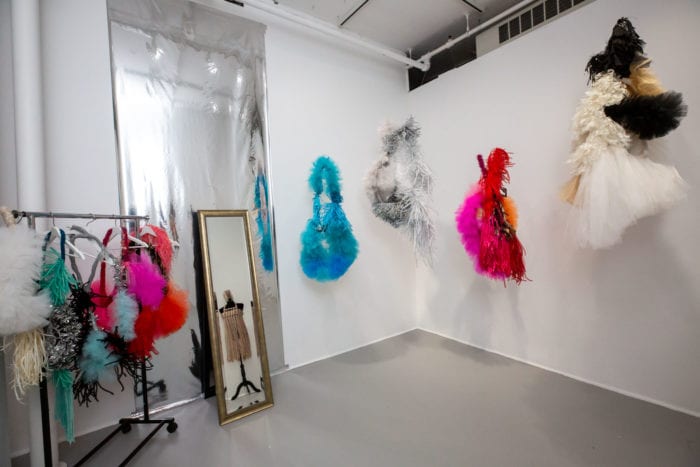
“Going to galleries and museums is going to be very different, because people are not going to be willing to stand in a room with one hundred other people.”
Hanging from the ceiling at different heights are four, multi-colored, wearable pieces, embellished with bird-like feathering and tufts of tulle. The sculptures are meant to look like armatures or exoskeletons, allowing a model who tries them on to transform into an otherworldly creature. Alongside these artworks is a rack with smaller designs, intended to be an interactive, public part of the installation, where spectators can try on the items in front of a mirror.
This commentary on fashion, developed by artist and curator Karen Meninno, is part of an exhibit called FeministFuturist, a project that opens a conversation on the role of women in shaping the future of society. The show opened in February at Boston Center for the Arts, but when the coronavirus escalated, the gallery had to close down. Instead, the center’s directors decided to produce the show virtually, including photographs, video footage, and text from the exhibit online for viewers to explore. Looking at the website, Meninno’s vision is brought to life, even for those quarantined at home.
“My concept was about how in the future, we’re all going to be tied into this singularity, artificial intelligence,” said Meninno. “We’re going to be wearing these smart suits that monitor everything about us, Big Brother and all that. You basically look like everyone else. But let’s not let go of our human nature, and let’s keep art in our human psyches, even if we’ve become cybernetic. I wanted to create very visually interesting pieces that would go over your smart suit. It would individualize you, amongst the herd.”
The visual arts world has been affected dramatically by the spread of the coronavirus, leaving many artists to question what creativity looks like during this time and whether art is even still relevant. For many, the limitations breed inspiration. Others argue that this work is more important than ever, giving people a way of processing crisis. The scene has been transformed in the wake of the virus, with many museums and galleries shifting to the virtual world as a way of allowing viewers to still access their art. Born out of the pandemic have been many new creative projects and developments.
Boston-based artist Eben Haines had envisioned the idea of creating miniature installations a year and a half ago, but he placed the production on hold and did not think about it until the quarantine happened. Haines decided to design the Shelter In Place Gallery, an Instagram exhibit featuring the work of different artists who submitted their pieces to him. He constructed an intricate, scaled down model of a room or loft space, which he described as his “dream” studio, and decorated it with tiny, stunningly realistic furniture. Other artists were invited to send in their own pieces to adorn the room, as long as they are at a scale of one inch to the foot. Having the whole project be miniature is a metaphor, in a sense, he said, paralleling how people cannot currently step into a gallery, in this current moment.
“The strange, silver lining of all this is that I have all day long to work on this, on my artwork,” said Haines. “That at first sounded like it was going to be the best, and then it became a lot of pressure to try and completely change my working habits over night. Making work is what I do. I always used my work to think through my own thoughts and feelings about how the world works and how I exist within it. Artists are probably having, not financially, but emotionally an easier time dealing with this, because a lot of what we do every day is sitting and thinking and working in silence.”
Nonprofit organization Artists for Humanity has also found ways of keeping the visual arts alive. The group traditionally hires low-income teens to find employment and work for pay in art and design, activating art as a tool that promotes social change, said marketing director Richard Frank. While the youth that the organization hires have had to remain at home during the virus, Artists for Humanity began to employ them remotely and delivered art supplies to their homes. It has also seen a transition to the virtual world, developing an initiative called the Social Distance Gallery, where pieces that the young artists previously developed are displayed online. Frank said that Artists for Humanity is creating a new project called Visions of the Future, which will allow the teens to reflect on their thoughts about the future through text and design original artwork using the supplies provided for them.
“Artists have always been at the forefront of both commentary about our present situation and aspirations for the future,” said Frank. “There’s a lot of talk about the change that will come, as we reemerge from this. …Teens, for them to go through this and have their lives disrupted, it’s really interesting for them to think about how they want to see things, once we reemerge, in the cities we want to live in. We’re making sure that we give a space for those teen voices.”
Haines said that the coronavirus has changed the way that we see art and that there will be a new way of perceiving works in person, once the pandemic subsides. Art draws people together, he said, and makes individuals aware of things they were unaware of before.
“People have very little to no access to art right now,” said Haines. “Going to galleries and museums is going to be very different, because people are not going to be willing to stand in a room with one hundred other people, at least not until we get a vaccine. The way it’s changed the way we move through the world, it’s going to change the way we move through institutions and other places where we access art. …Art just has more life to it when you’re standing in front of it.”
Meninno said that in some ways, the coronavirus has been liberating, as the restrictions it has created challenge artists to find new channels for their ideas. In this sense, the pandemic has provided an opportunity for discovery.
“That’s what I’m revisiting right now, why am I doing art?” said Meninno. “It’s getting back to original passion. In this time, where we’re locked down, and we’re just going stir crazy, it’s almost like we have to start to play again. We need to let our inner child come out and play again. It’s safe to be in your home and make artwork. Even if you can’t go outside, you can go inside. When you bring that out through this work, the new work that people are creating under the coronavirus, you’re going to get a sense of freedom. …Some of the best creative work comes from people under limitations.”
FeministFuturist, curated by Karen Meninno and Carolyn Wirth, Boston Center for the Arts,
bostonarts.org/experiences/exhibitions/feministfuturist/.
Shelter in Place Gallery, curated by Eben Haines,
instagram.com/shelterinplacegallery/?hl=en.
Social Distance Gallery, Artists for Humanity,
afhboston.org/socialdistancegallery.html.
Shira Laucharoen is a reporter based in Boston. She currently serves as the assistant director of the Boston Institute for Nonprofit Journalism. In the past she has written for Sampan newspaper, The Somerville Times, Scout Magazine, Boston Magazine, and WBUR.

